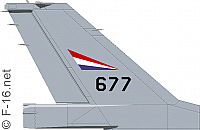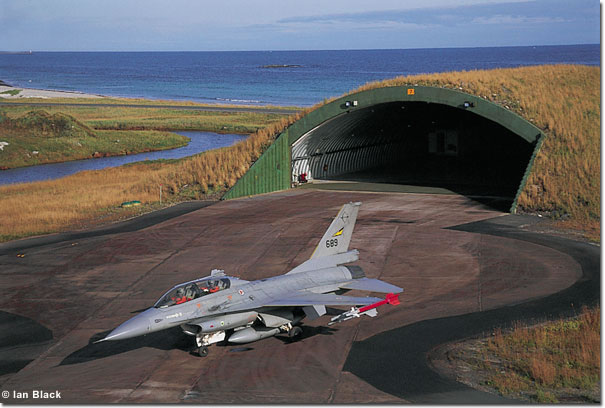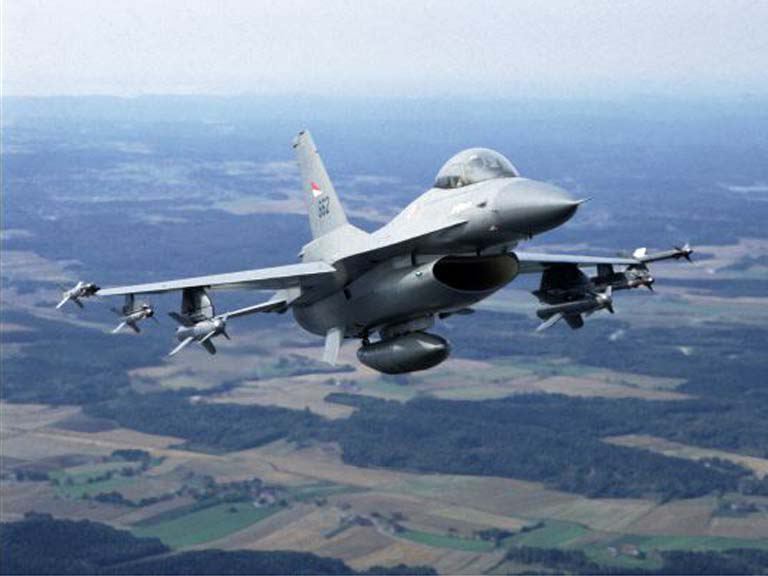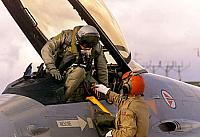Introduction
The Royal Norwegian Air Force (Luftforsvaret) was one of the four initial European Participating Air Forces and ordered a total of 74 F-16A/B aircraft. Of these, 56 were updated under the MLU program. Norwegian F-16s will be replaced in 2015, with the most likely candidates being the F-35 Lightning II and the Eurofighter Typhoon.
History
In 1970, Norway started looking for a replacement for its aging fleet of F-104 Starfighters. Likely candidates included the Mirage F.1, Saab 37 Viggen, and the winner of the Light-Weight Fighter competition (either the Northrop F-17 or the F-16).
Inventory
Initial Order
On July 21st 1975, Norway, Belgium, the Netherlands and Denmark ordered the F-16. Together, they formed in the late 70's the European consortium which was to build the F-16 under license. Norway acquired 60 F-16A's and 12 F-16B's from the Netherlands' Fokker production line between January of 1980 and June of 1984.
The first Fighting Falcon for the Luftforsvaret (Royal Norwegian Air Force) took off for its maiden flight on December 12th, 1979. All block 1 and block 5 aircraft have been rebuilt to block 10 standard. The RNoAF F-16s carry an unusual all light gray color scheme, with the Norwegian flag on the tail, together with a 3-digit serial number derived from the US serial, and roundels on the fuselage.
Attrition Replacements
Two F-16B Block 15 aircraft have been ordered as attrition replacements. They were not built on the Fokker production line, but delivered directly from General Dynamics.
Possible Future Orders
The service hopes to acquire between 30 and 40 new fighters to replace the F-5A/B fighters operated by Rygge-based 336 Squadron, the RNoAF's fifth fighter squadron. The 40 new aircraft are also meant as attrition replacement for F-16s lost over the years. After an evaluation of five potential aircraft, the ministry of defense announced in February 1999 that the choice had been narrowed to the Eurofighter Typhoon and the Lockheed Martin F-16C/D Block 50N. If the program receives Parliamentary approval, which the MoD hopes will take place in mid-year, a Request for Proposals (RfP) will be issued immediately. This could lead to a contract being placed by the end of 1999. Deliveries would begin in 2003. The aircraft will most likely be deployed with 338 sqn at Ørland, and 336 sqn at Rygge. The latter might possibly merge with 338 sqn.
In February 1999, the Defense Ministry announced it issued a letter of procurement, asking the Eurofighter consortium and LMTAS for offers to supply 20 jets in the period 2003 to 2010 with an option for 10 additional aircraft. The suppliers were requested to offer alternative payment- and delivery schedules. The requests also include a demand for 100 percent offset, under which Norwegian industry would be guaranteed the equivalent of the total cost of the order in other contracts.
However, during the year 2000 the Norwegian government announced a round of restructures. One of the measures was to abandon the plans for new fighters to replace the F-5s. Norway will now wait until the introduction of the JSF so as to perhaps replace all its fighters at once.
Beyond 2015, the RNoAF plans to replace its F-16s with 40 new fighters. Norway has committed about $10 million to be an 'associate partner' in the US Joint Strike Fighter (JSF) project, although officials stress this involves no commitment to buy the JSF.
End of service
In the course of 2021 the RNoAF was already sending F-16s who were 'out of life' to Kjeller depot to be stored there. The vast majority of aircraft that still had hours left flew untill December of 2021 and were stored at that time as well. On January 6th, 2022 the flying era of Norwegian F-16s ended after 42 years of operations when the last flight was performed. This however does not mean the end of these F-16s. They were maintained well by the Norwegians and most airframes still have airframe hours left. On December 20th, 2021 the Romanian government signed an LOI for the acquisition of up to 32 airframes in a deal worth up to $513 million. Another 12 airframes are set to go to Draken International, the US company providing red air combat support to other air forces.
| Program | Model | Block | Qty. | Serials | Delivered |
|---|---|---|---|---|---|
| Initial Order | F-16A | Block 1 | 3 | 272/274 | 1980 |
| F-16B | Block 1 | 2 | 301/302 | 1980 | |
| F-16A | Block 5 | 10 | 275/284 | 1980-1981 | |
| F-16B | Block 5 | 2 | 303/304 | 1980-1981 | |
| F-16A | Block 10 | 15 | 285/299 | 1981-1982 | |
| F-16B | Block 10 | 3 | 305/307 | 1981-1982 | |
| F-16A | Block 15 | 32 | 300,658/688 | 1982-1984 | |
| F-16B | Block 15 | 5 | 689/693 | 1982-1983 | |
| Attrition | F-16B | Block 15 OCU | 2 | 711/712 | 1989 |
Modifications & Armament
Modifications
Norway's short and snowy runways, which are often located at dispersed sites, dictated that their F-16s be fitted with braking parachutes to handle situations where ordinary wheel brakes could not be used. These chutes are housed inside a large rectangular extension at the base of the tail fin, and Norwegian F-16s were actually the first F-16s to be fitted with chutes.All Norwegian F-16A's (but none of the B-models) also carry an identification spotlight (similar to the example fitted to Danish F-16s used for identifying during nighttime intercepts. The spotlight is nicknamed 'Russer-lyset' (which translates to 'The Russian Light') for obvious reasons.
Royal Norwegian Air Force F-16s are equipped with the Northrop Grumman AN/ALQ-162 internally mounted deception jammer. In April 1998, Norway decided to acquire the Shadowbox II upgrade for the AN/ALQ-162. This will increase the capability of the baseline jammer to deny lock-on by pulse-Doppler (PD) and airborne intercept (AI) radar threats.
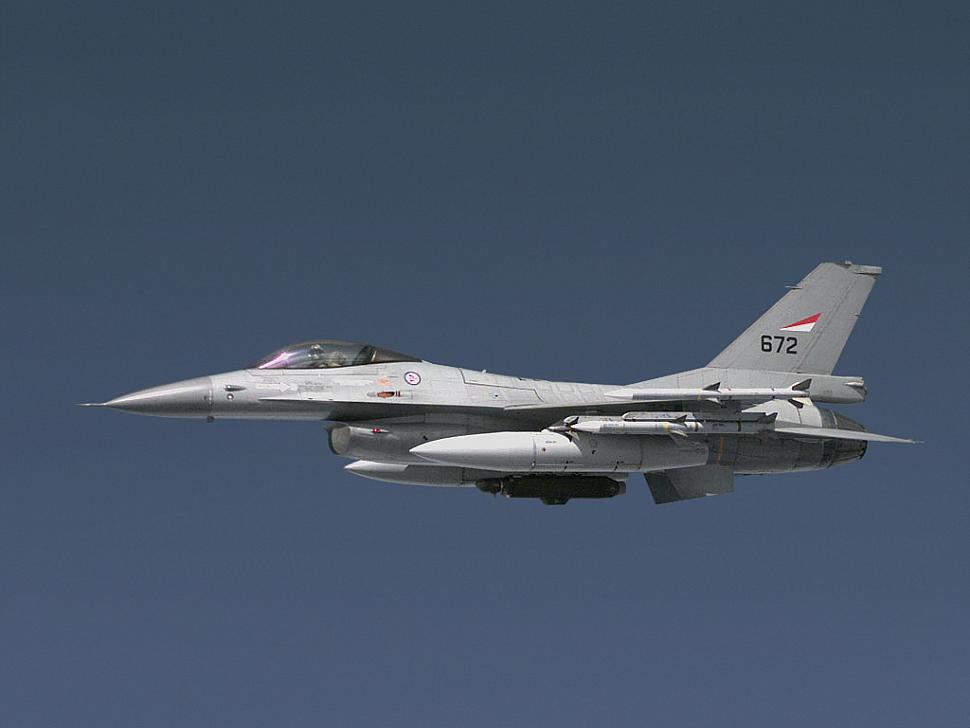
Mid-life Update
Norway participates in the MLU program and will submit a total of 56 airframes - 11 Bravo's and 45 Alpha's (all Block 10 or 15 a/c). The number of MLU kits ordered totaled one less than the F-16 inventory at the time. The reason for this was that, statistically the RNoAF would loose at least one aircraft before the project got underway. The aircraft lost to even up the aircraft-to-kit ratio was #78-0274. F-16A #299 from 338skv is Norway's TVI-airframe (Trial Verification Installation) and flies in American colors with the OT&E (Operational Test & Evaluation) unit. Work on the last MLU aircraft at the Air Force Depot in Kjeller was completed in December 2001.
Armament
Standard RNoAF F-16 armament includes the AIM-9L Sidewinder missiles. The Norwegian F-16s have an important anti-shipping role, and can also carry and launch the locally built Kongsberg Penguin anti-ship missile. Deliveries of the Penguin 3 began in 1987. The Penguin missile was also tested by the USAF under the designation AGM-119. Mid-course guidance is by an inertial system and radio altimeter, while final aiming is by an infrared seeker. Penguin missiles have been supplied to Skvadron 334.
The MLU saw the introduction of the AIM-120 AMRAAM. In a program expected to cost NKr4.5 billion (USD $602.2 million), the RNoAF is acquiring the AIM-120B Advanced Medium-Range Air-to-Air Missile (AMRAAM) - providing a beyond-visual-range air-to-air capability for the first time. Deliveries, under a Foreign Military Sales (FMS) contract with the USA, began in 1995 and were completed in 2000.
Royal Norwegian Air Force F-16s used Paveway II (Mk 82) laser-guided bombs for the first time in September 1997. Laser designation for the weapons, lacking LANTIRN pods for the F-16 at the time, is provided by forward air control team from the Telemark Battalion, the Norwegian Army's contribution to NATO's Immediate Reaction Forces (IRF).
Operational Service
Units
Please refer to the F-16 Units section for an overview of units.Deployments
|
Allied Force Grazzanise AB, Italy, 1999 During operation 'Allied Force' in 1999, Norway participated with a number of F-16s stationed at Grazzanise AFB in Italy, together with F-16s from Denmark. Norwegian F-16s, just like the Danish aircraft, most of the time undertook CAP missions. The RNoAF didn't send their MLU F-16s over to Italy. |
|
|
Enduring Freedom Manas AB, Kyrgyzstan, 2002 In 2002 the Norwegian government decided to send F-16s to Afghanistan in support of operation 'Enduring Freedom'. Their aircraft are stationed at Manas AFB in Kyrgyzstan together with aircraft from The Netherlands and Denmark. Operations have been flown from October 2002 to October 2003, although Norway decided to retract their F-16s early. All EPAF countries, except for Belgium, have flown together in this operation. |
|
|
Baltic Republics Air Police Lithuania, 2004 In succession of Belgium and Denmark, Norway sent 4 F-16 fighters for patrolling the air of the three Baltic republics - Latvia, Lithuania and Estonia - From January 12th till March 31st, 2005 they provided air cover over the Baltic states being supplemented by Dutch F-16s. |
|
|
Unified Protector Libya, 2011 Together with a number of NATO and Arab League countries, Norwegian F-16s took part in the UN directed operation to protect the Libyan civilian population. The operation lasted untill October of 2011, but the Norwegians already withdrew their contingent in August. |
Special thanks
- Jakob Ubostad Carlsen.
It looks like it's been 9 years. Time for a refresher, no?
Thanks. Black skies and headwinds.
Lt Col Achilleas "Flare" Katsos
Please use this form to add any list any error or omissions you find in the above text.
Note: your comments will be displayed immediately on this page. If you wish to send a private comment to the webmasters, please use the Contact Us link.

